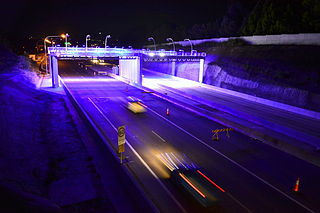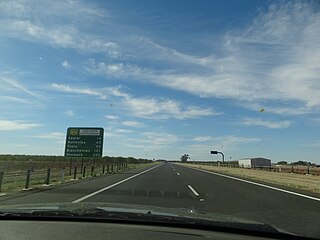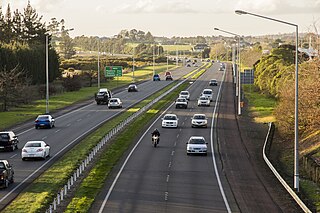
The Southern Expressway is an 18.5 km (11.5 mi) freeway in the southern suburbs of Adelaide, South Australia, between Bedford Park and Old Noarlunga. It is the southern part of the North–South Corridor which extends the full length of Adelaide and is being built to urban freeway standard.
Port Wakefield Road is an important Australian highway. It connects Adelaide, the South Australian capital, to the Yorke Peninsula, Port Augusta, northern and western South Australia, the Northern Territory and Western Australia. It is designated National Highway A1 and a part of the National Highway. It is named after Port Wakefield, the first government town north of Adelaide.

Stoney Trail is a 69-kilometre (43 mi) freeway in Calgary, Alberta. Signed as Highway 201, it is a ring road that is approximately 70% complete, serving as an important bypass around the city and an alternate route to the congested Highway 1 and Highway 2. Stoney Trail begins in the city's northwest at Highway 1 near Canada Olympic Park, running north across the Bow River and Crowchild Trail. It winds through neighbourhoods of northwest Calgary to Deerfoot Trail and the Queen Elizabeth II Highway. Turning south, the freeway again intersects Highway 1, crosses Glenmore Trail, and curves west at the neighbourhood of Mahogany. Beyond a second major interchange with Deerfoot Trail, it descends across the Bow River and ends at Macleod Trail in the city's southeast.

South Road, also known as Main South Road, is a major north–south conduit in Adelaide and Fleurieu Peninsula in South Australia. It is one of Adelaide's most important arterial and bypass roads.
The Port River Expressway is a 5.5-kilometre (3.4 mi) freeway-grade road. The expressway links Port Adelaide and the LeFevre Peninsula to the northern suburbs of Adelaide and major interstate routes via Salisbury Highway (A9) to Port Wakefield Road (A1) and the Max Fatchen Northern Expressway (M2) to Perth, Darwin and Sydney.

The Hills Motorway is a tollway in north-western Sydney, Australia, owned by toll road operator Transurban. It forms part of Sydney's M2 route and the 110 km Sydney Orbital Network. West of Pennant Hills Road, the M2 is also part of the National Highway.

The M4 Motorway is a 51.5-kilometre-long (32.0 mi) dual carriageway motorway in Sydney, New South Wales, Australia that is designated with the M4 route. The M4 designation is part of the wider A4 and M4 route designation. It runs parallel to the Great Western Highway and Parramatta Road.

The Northern Expressway, also known as the Fatchen Northern Expressway, is a 23 kilometre long controlled-access highway in Adelaide, South Australia. It travels from Gawler to Port Wakefield Road. The road has been built to four-lane standard and provides a faster route between Adelaide and Gawler, whilst reducing the amount of traffic on Main North Road, which passes through the heart of the northern suburbs and is interspersed with frequent traffic lights. It also allows freight vehicles to avoid residential areas and go straight to Port Wakefield Road and onto the Port River Expressway (A9) to reach the harbour at Port Adelaide.

The Auckland Northern Motorway in the Auckland Region of New Zealand links central Auckland City and Puhoi in the former Rodney District via the Hibiscus Coast and North Shore. It is part of State Highway 1.

The Auckland Southern Motorway is the major route south out of the Auckland Region of New Zealand. It is part of State Highway 1.
The Salisbury Highway is a 12 kilometre major connecting road in the northern suburbs of the Adelaide metropolitan area.

The Hunter Expressway is a 39.5-kilometre (24.5 mi) long dual carriageway freeway in New South Wales, Australia. It was previously known as the F3 to Branxton link or Kurri Kurri Corridor during the planning stage. It has two lanes in each direction, running generally north west from the Pacific Motorway at the Newcastle Link Road interchange to the eastern end of the Belford Bends Deviation on the New England Highway north of Branxton. The road allows traffic to bypass the Maitland area, Lochinvar, Greta and Branxton. The expressway opened on 22 March 2014.

State Highway 2 runs north–south through eastern parts of the North Island of New Zealand from the outskirts of Auckland to Wellington. It runs via Tauranga in the Bay of Plenty, Gisborne, and Napier and Hastings in Hawke's Bay. It is the second-longest highway in the North Island, after State Highway 1, which runs the length of both of the country's main islands.

Highways in Croatia are the main transport network in Croatia. The Croatian classification includes several classes of highways:
This is a list of freeways in Australia, sorted by states and territories and their corresponding routes. This list includes tollways / toll roads such as the CityLink freeway system in Melbourne. This list has over 70 entries. The only jurisdiction in Australia without freeways is the Northern Territory. Victoria has the largest and densest freeway network in Australia.

Bundesautobahn 100 is an Autobahn in Germany.
State Highway 74 is a state highway in New Zealand servicing the eastern suburbs of Christchurch. Mostly two-lane, it is composed of limited-access expressways, with part of the highway as the Christchurch-Lyttelton Motorway, and connects the city to its port town of Lyttelton.

The North–South Motorway is an incomplete planned motorway traversing the inner western suburbs of Adelaide from Wingfield in the north to Bedford Park in the south. It is planned to be a non-stop north–south route overlaying the same motor traffic corridor as South Road by grade separation. The motorway is to be the central section of Adelaide's North–South Corridor, being flanked north and south by the Northern Expressway and Southern Expressway, respectively.

The North–South Corridor is a series of road projects currently under construction or planning which travel through Adelaide, South Australia that will eventually form a continuous link from Old Noarlunga in the outer southern metropolitan Adelaide suburbs through to Nuriootpa in the inner northern rural area around the Barossa Valley, a distance of over 100 km, aiming to be without a single stop by 2030.
McIntyre Road and Kings Road are arterial roads crossing the northern and northeastern suburbs of Adelaide in South Australia. They are together denoted as route A18.













